check engine LAND ROVER FREELANDER 2001 Workshop Manual
[x] Cancel search | Manufacturer: LAND ROVER, Model Year: 2001, Model line: FREELANDER, Model: LAND ROVER FREELANDER 2001Pages: 1007, PDF Size: 23.47 MB
Page 7 of 1007

CONTENTS
4CONTENTS
MAINTENANCE ........................................................................................ 10-1
MAINTENANCE
Td4 - Diesel Engine - Under Bonnet View ...................................................................................... 10-1
K1.8 – Petrol Engine – Under Bonnet View .................................................................................... 10-2
KV6 – Petrol Engine – Under Bonnet View .................................................................................... 10-3
Seats and Seat Belts ...................................................................................................................... 10-4
Lamps, Horns and Warning Indicators ........................................................................................... 10-4
Wipers and Washers ...................................................................................................................... 10-5
Handbrake ...................................................................................................................................... 10-5
Alarm Handset Battery.................................................................................................................... 10-6
Road Wheels .................................................................................................................................. 10-6
Tyres ............................................................................................................................................... 10-7
Brake Pads and Calipers ................................................................................................................ 10-7
Brake Fluid...................................................................................................................................... 10-9
Road Wheel Speed Sensors .......................................................................................................... 10-9
Fuel Filter - Petrol ........................................................................................................................... 10-10
Fuel Filter - Diesel........................................................................................................................... 10-10
Fuel Pump and Filter assembly - Diesel - 03 Model Year onwards ................................................ 10-10
Fuel Sedimenter - Diesel - 03 Model Year onwards ....................................................................... 10-10
Door Locks, Hinges, Check Straps and Bonnet Catch ................................................................... 10-11
Anti-freeze ...................................................................................................................................... 10-12
Cooling System and Intercooler...................................................................................................... 10-12
Vent filter - turbocharger boost control solenoid valve - Td4 .......................................................... 10-13
Spark Plugs – K1.8 ......................................................................................................................... 10-13
Spark Plugs – KV6.......................................................................................................................... 10-13
Air Cleaner – Petrol Models ............................................................................................................ 10-13
Ancillary Drive Belt – Td4 ............................................................................................................... 10-14
Ancillary Drive Belt – K1.8 .............................................................................................................. 10-14
Ancillary Drive Belt – KV6 ............................................................................................................... 10-15
Camshaft Timing Belt – K1.8 .......................................................................................................... 10-15
Camshaft Timing Belt – KV6........................................................................................................... 10-16
Brake/Clutch Reservoir ................................................................................................................... 10-16
PAS Fluid Level .............................................................................................................................. 10-17
Intermediate Reduction Drive - Non NAS models .......................................................................... 10-17
Intermediate Reduction Drive - NAS models .................................................................................. 10-18
Manual Gearbox – PG1 .................................................................................................................. 10-18
Manual Gearbox – GETRAG .......................................................................................................... 10-19
Automatic Gearbox – JATCO ......................................................................................................... 10-19
Rear Axle ........................................................................................................................................ 10-20
Clutch Pipes and Unions ................................................................................................................ 10-21
Windscreen and Rear Washer Reservoir ....................................................................................... 10-21
Battery ............................................................................................................................................ 10-21
Engine Oil and Filter – Td4 ............................................................................................................. 10-22
Engine Oil and Filter – K1.8 ............................................................................................................ 10-23
Engine Oil and Filter – KV6 ............................................................................................................ 10-24
Fuel Hoses and Pipes..................................................................................................................... 10-25
Brake Hoses and Pipes ................................................................................................................. 10-26
Check Exhaust System................................................................................................................... 10-26
Suspension ..................................................................................................................................... 10-27
Steering ......................................................................................................................................... 10-28
Road Test ....................................................................................................................................... 10-28
Endorse Service Record ................................................................................................................. 10-30
Report any Unusual Features ......................................................................................................... 10-30
Page 8 of 1007

CONTENTS
CONTENTS 5
ENGINE - K SERIES KV6 ......................................................................... 12-3-1
ADJUSTMENTS
Engine oil pressure check ............................................................................................................... 12-3-1
REPAIRS
Camshafts - LH cylinder head......................................................................................................... 12-3-3
Camshafts - RH cylinder head ........................................................................................................ 12-3-5
Inlet camshaft front oil seal ............................................................................................................. 12-3-8
Camshaft rear oil seal ..................................................................................................................... 12-3-9
Pulley - crankshaft ......................................................................................................................... 12-3-10
Crankshaft front oil seal .................................................................................................................. 12-3-11
Crankshaft rear oil seal ................................................................................................................... 12-3-12
Cylinder head gasket - LH .............................................................................................................. 12-3-13
Cylinder head gasket - RH .............................................................................................................. 12-3-16
Camshaft cover gasket - LH - Up to 03MY ..................................................................................... 12-3-20
Camshaft cover gasket - LH - from 03MY ....................................................................................... 12-3-21
Camshaft cover gasket - RH ........................................................................................................... 12-3-23
Cover - engine acoustic ................................................................................................................. 12-3-25
Engine and automatic gearbox - up to 03MY .................................................................................. 12-3-25
Engine and automatic gearbox - from 03MY .................................................................................. 12-3-35
Arm assembly - engine mounting RH ........................................................................................... 12-3-45
Engine mounting - LH ..................................................................................................................... 12-3-46
Hydramount - engine - RH ............................................................................................................. 12-3-47
Engine steady - upper RH ............................................................................................................... 12-3-47
Engine steady - lower ..................................................................................................................... 12-3-48
Torque converter drive plate ........................................................................................................... 12-3-49
Filter - engine oil ............................................................................................................................ 12-3-50
Oil pick-up strainer .......................................................................................................................... 12-3-50
Gasket - oil pump ........................................................................................................................... 12-3-51
Sump - reseal.................................................................................................................................. 12-3-53
Switch - oil pressure ....................................................................................................................... 12-3-54
Oil pressure relief valve .................................................................................................................. 12-3-55
Oil cooler - engine ........................................................................................................................... 12-3-57
Camshaft timing belt ....................................................................................................................... 12-3-58
Camshaft timing belt cover - RH front ............................................................................................. 12-3-66
Camshaft timing belt cover - LH front ............................................................................................. 12-3-67
Camshaft timing belt cover - LH rear .............................................................................................. 12-3-68
Camshaft timing belt cover - RH rear .............................................................................................. 12-3-68
Camshaft rear timing belt - LH cylinder head .................................................................................. 12-3-69
Camshaft rear timing belt - RH cylinder head ................................................................................. 12-3-73
OVERHAUL
Piston assemblies - engine set ....................................................................................................... 12-3-77
Crankshaft front oil seal ................................................................................................................ 12-3-80
Crankshaft rear oil seal ................................................................................................................... 12-3-81
Crankshaft....................................................................................................................................... 12-3-82
Cylinder head gasket - LH .............................................................................................................. 12-3-87
Cylinder head gasket - RH .............................................................................................................. 12-3-91
Cylinder head - decarbonise ........................................................................................................... 12-3-94
Oil pump - Overhaul ........................................................................................................................ 12-3-104
Sump - engine oil ........................................................................................................................... 12-3-106
Camshaft timing belt ....................................................................................................................... 12-3-107
Page 33 of 1007
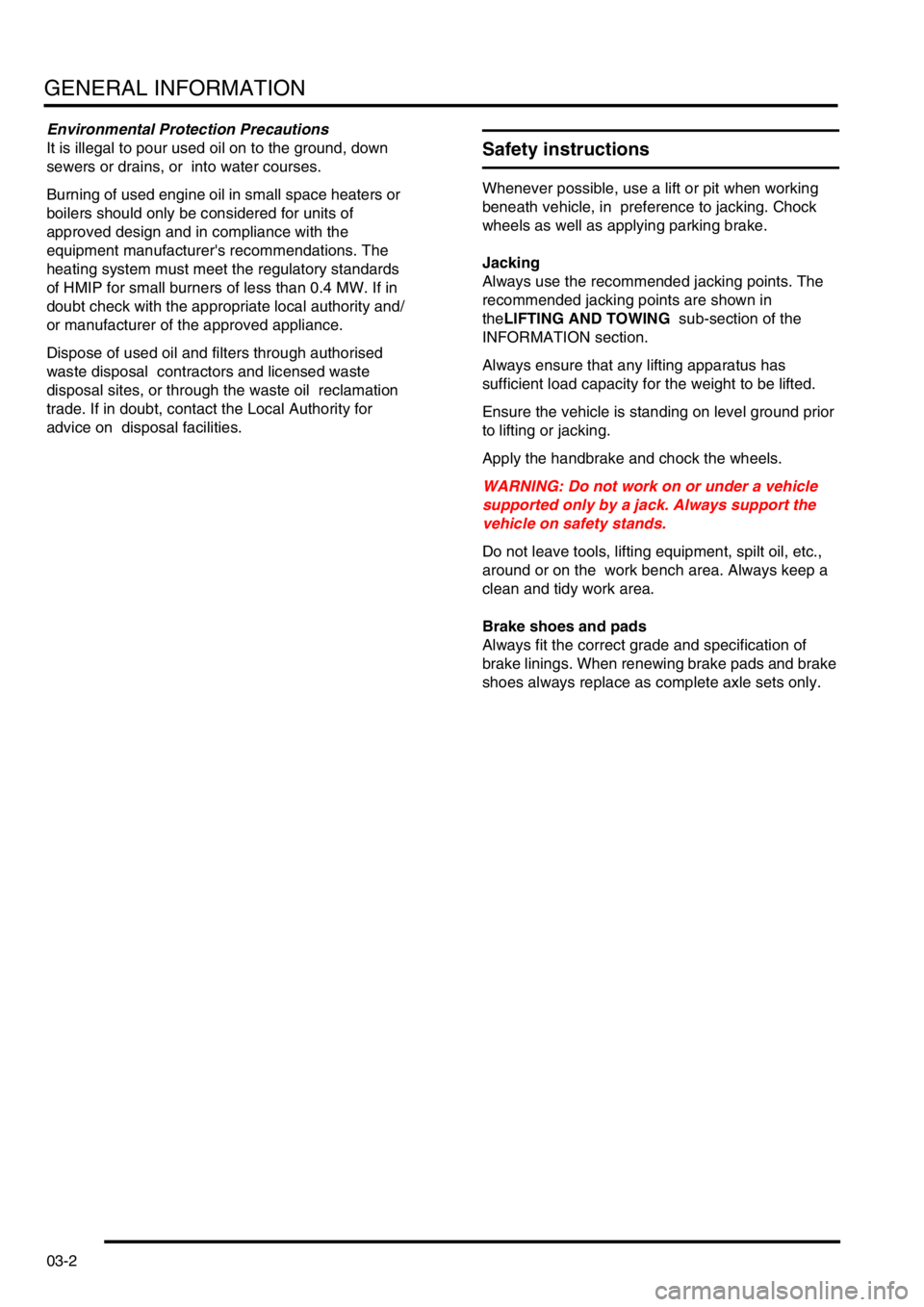
GENERAL INFORMATION
03-2
Environmental Protection Precautions
It is illegal to pour used oil on to the ground, down
sewers or drains, or into water courses.
Burning of used engine oil in small space heaters or
boilers should only be considered for units of
approved design and in compliance with the
equipment manufacturer's recommendations. The
heating system must meet the regulatory standards
of HMIP for small burners of less than 0.4 MW. If in
doubt check with the appropriate local authority and/
or manufacturer of the approved appliance.
Dispose of used oil and filters through authorised
waste disposal contractors and licensed waste
disposal sites, or through the waste oil reclamation
trade. If in doubt, contact the Local Authority for
advice on disposal facilities.
Safety instructions
Whenever possible, use a lift or pit when working
beneath vehicle, in preference to jacking. Chock
wheels as well as applying parking brake.
Jacking
Always use the recommended jacking points. The
recommended jacking points are shown in
theLIFTING AND TOWING sub-section of the
INFORMATION section.
Always ensure that any lifting apparatus has
sufficient load capacity for the weight to be lifted.
Ensure the vehicle is standing on level ground prior
to lifting or jacking.
Apply the handbrake and chock the wheels.
WARNING: Do not work on or under a vehicle
supported only by a jack. Always support the
vehicle on safety stands.
Do not leave tools, lifting equipment, spilt oil, etc.,
around or on the work bench area. Always keep a
clean and tidy work area.
Brake shoes and pads
Always fit the correct grade and specification of
brake linings. When renewing brake pads and brake
shoes always replace as complete axle sets only.
Page 34 of 1007
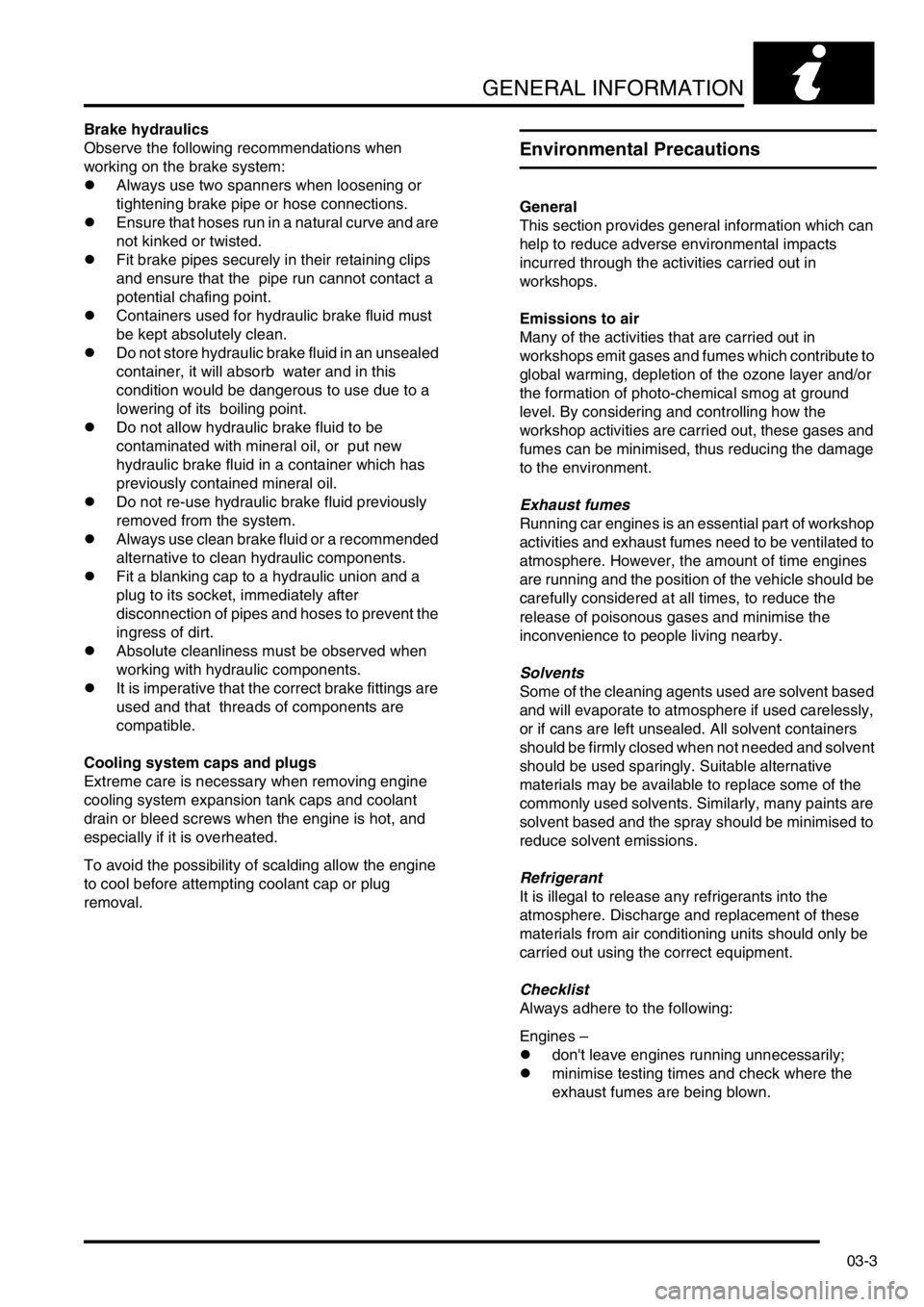
GENERAL INFORMATION
03-3
Brake hydraulics
Observe the following recommendations when
working on the brake system:
lAlways use two spanners when loosening or
tightening brake pipe or hose connections.
lEnsure that hoses run in a natural curve and are
not kinked or twisted.
lFit brake pipes securely in their retaining clips
and ensure that the pipe run cannot contact a
potential chafing point.
lContainers used for hydraulic brake fluid must
be kept absolutely clean.
lDo not store hydraulic brake fluid in an unsealed
container, it will absorb water and in this
condition would be dangerous to use due to a
lowering of its boiling point.
lDo not allow hydraulic brake fluid to be
contaminated with mineral oil, or put new
hydraulic brake fluid in a container which has
previously contained mineral oil.
lDo not re-use hydraulic brake fluid previously
removed from the system.
lAlways use clean brake fluid or a recommended
alternative to clean hydraulic components.
lFit a blanking cap to a hydraulic union and a
plug to its socket, immediately after
disconnection of pipes and hoses to prevent the
ingress of dirt.
lAbsolute cleanliness must be observed when
working with hydraulic components.
lIt is imperative that the correct brake fittings are
used and that threads of components are
compatible.
Cooling system caps and plugs
Extreme care is necessary when removing engine
cooling system expansion tank caps and coolant
drain or bleed screws when the engine is hot, and
especially if it is overheated.
To avoid the possibility of scalding allow the engine
to cool before attempting coolant cap or plug
removal.
Environmental Precautions
General
This section provides general information which can
help to reduce adverse environmental impacts
incurred through the activities carried out in
workshops.
Emissions to air
Many of the activities that are carried out in
workshops emit gases and fumes which contribute to
global warming, depletion of the ozone layer and/or
the formation of photo-chemical smog at ground
level. By considering and controlling how the
workshop activities are carried out, these gases and
fumes can be minimised, thus reducing the damage
to the environment.
Exhaust fumes
Running car engines is an essential part of workshop
activities and exhaust fumes need to be ventilated to
atmosphere. However, the amount of time engines
are running and the position of the vehicle should be
carefully considered at all times, to reduce the
release of poisonous gases and minimise the
inconvenience to people living nearby.
Solvents
Some of the cleaning agents used are solvent based
and will evaporate to atmosphere if used carelessly,
or if cans are left unsealed. All solvent containers
should be firmly closed when not needed and solvent
should be used sparingly. Suitable alternative
materials may be available to replace some of the
commonly used solvents. Similarly, many paints are
solvent based and the spray should be minimised to
reduce solvent emissions.
Refrigerant
It is illegal to release any refrigerants into the
atmosphere. Discharge and replacement of these
materials from air conditioning units should only be
carried out using the correct equipment.
Checklist
Always adhere to the following:
Engines –
ldon't leave engines running unnecessarily;
lminimise testing times and check where the
exhaust fumes are being blown.
Page 36 of 1007

GENERAL INFORMATION
03-5
Local issues
A number of environmental issues will be of
particular concern to residents and other neighbours
close to the site. The sensitivity of these issues will
depend on the proximity of the site and the layout
and amount of activity carried on at the site.
Noise is a major concern and therefore consideration
should be given to the time spent carrying out noisy
activities and the location of those activities that can
cause excessive noise.
Car alarm testing, panel beating, hammering and
other such noisy activities should, whenever
possible, be carried out indoors with doors and
windows shut, or as far away from houses as
possible.
Running vehicle engines may be an outside activity
which could cause nuisance to neighbours because
of both noise and smell.
Be sensitive to the time of day when these activities
are carried out and minimise the time of the noisy
operation, particularly in the early morning and late
evening.
Another local concern will be the smell from the
various materials used. Using less solvent, paint and
petrol could help prevent this annoyance.
Local residents and other business users will also be
concerned about traffic congestion, noise and
exhaust fumes, be sensitive to these concerns and
try to minimise inconvenience from deliveries,
customers and servicing operations.
Checklist
Always adhere to the following:
lidentify where the neighbours who are likely to
be affected are situated;
lminimise noise, smells and traffic nuisance;
lprevent litter by putting waste in the correct
containers;
lhave waste skips emptied regularly.Use of resource
Another environmental concern is the waste of
materials and energy that can occur in day to day
activities.
Electricity for heating, lighting and compressed air
uses resources and releases pollution during its
generation.
Fuel used for heating, running cars or vans and
mobile plant is another limited resource which
consumes large amounts of energy during its
extraction and refining processes.
Water has to be cleaned, piped to site and disposed
of, all of which creates more potential pollution;
Oil, spares, paint etc., have all produced pollution in
the process of manufacture and they become a
waste disposal problem if discarded.
Checklist
Always adhere to the following:
Electricity and heating –
lkeep doors and windows closed in the winter;
lswitch off machinery or lights when not needed;
luse energy efficient heating systems;
lswitch off computers and photocopiers when
not needed.
Fuel –
ldon't run engines unnecessarily;
lthink about whether journeys are necessary and
drive to conserve fuel.
Water –
ldon't leave taps and hose pipes running;
lmend leaks quickly, don't be wasteful.
Compressed air –
ldon't leave valves open;
lmend leaks quickly;
ldon't leave the compressor running when not
needed.
Use of environmentally damaging materials –
lcheck whether a less toxic material is available.
Handling and storage of materials –
lhave the correct facilities available for handling
liquids to prevent spillage and wastage as listed
above;
lprovide suitable locations for storage to prevent
frost damage or other deterioration.
Page 48 of 1007
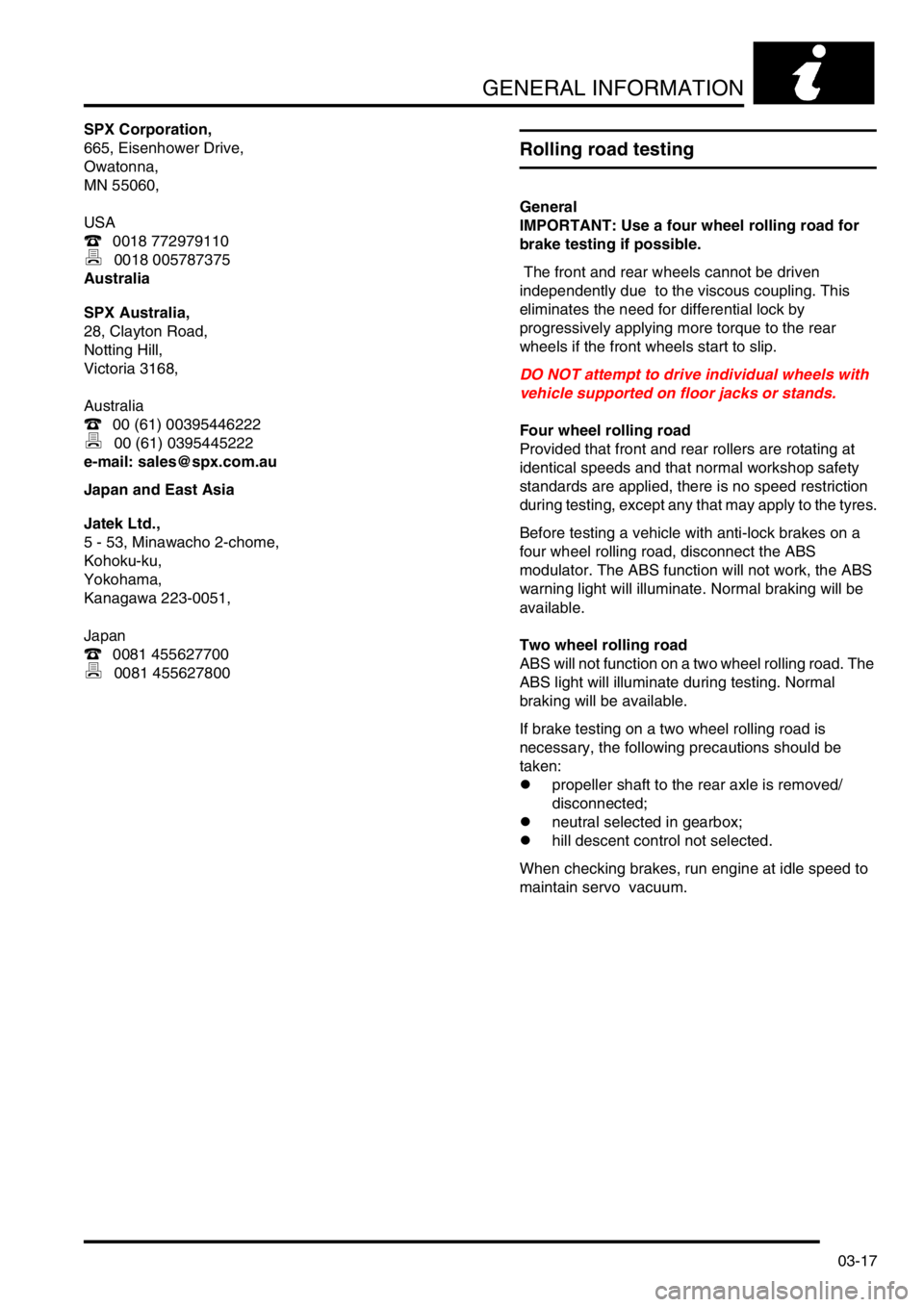
GENERAL INFORMATION
03-17
SPX Corporation,
665, Eisenhower Drive,
Owatonna,
MN 55060,
USA
( 0018 772979110
) 0018 005787375
Australia
SPX Australia,
28, Clayton Road,
Notting Hill,
Victoria 3168,
Australia
( 00 (61) 00395446222
) 00 (61) 0395445222
e-mail: [email protected]
Japan and East Asia
Jatek Ltd.,
5 - 53, Minawacho 2-chome,
Kohoku-ku,
Yokohama,
Kanagawa 223-0051,
Japan
( 0081 455627700
) 0081 455627800
Rolling road testing
General
IMPORTANT: Use a four wheel rolling road for
brake testing if possible.
The front and rear wheels cannot be driven
independently due to the viscous coupling. This
eliminates the need for differential lock by
progressively applying more torque to the rear
wheels if the front wheels start to slip.
DO NOT attempt to drive individual wheels with
vehicle supported on floor jacks or stands.
Four wheel rolling road
Provided that front and rear rollers are rotating at
identical speeds and that normal workshop safety
standards are applied, there is no speed restriction
during testing, except any that may apply to the tyres.
Before testing a vehicle with anti-lock brakes on a
four wheel rolling road, disconnect the ABS
modulator. The ABS function will not work, the ABS
warning light will illuminate. Normal braking will be
available.
Two wheel rolling road
ABS will not function on a two wheel rolling road. The
ABS light will illuminate during testing. Normal
braking will be available.
If brake testing on a two wheel rolling road is
necessary, the following precautions should be
taken:
lpropeller shaft to the rear axle is removed/
disconnected;
lneutral selected in gearbox;
lhill descent control not selected.
When checking brakes, run engine at idle speed to
maintain servo vacuum.
Page 50 of 1007
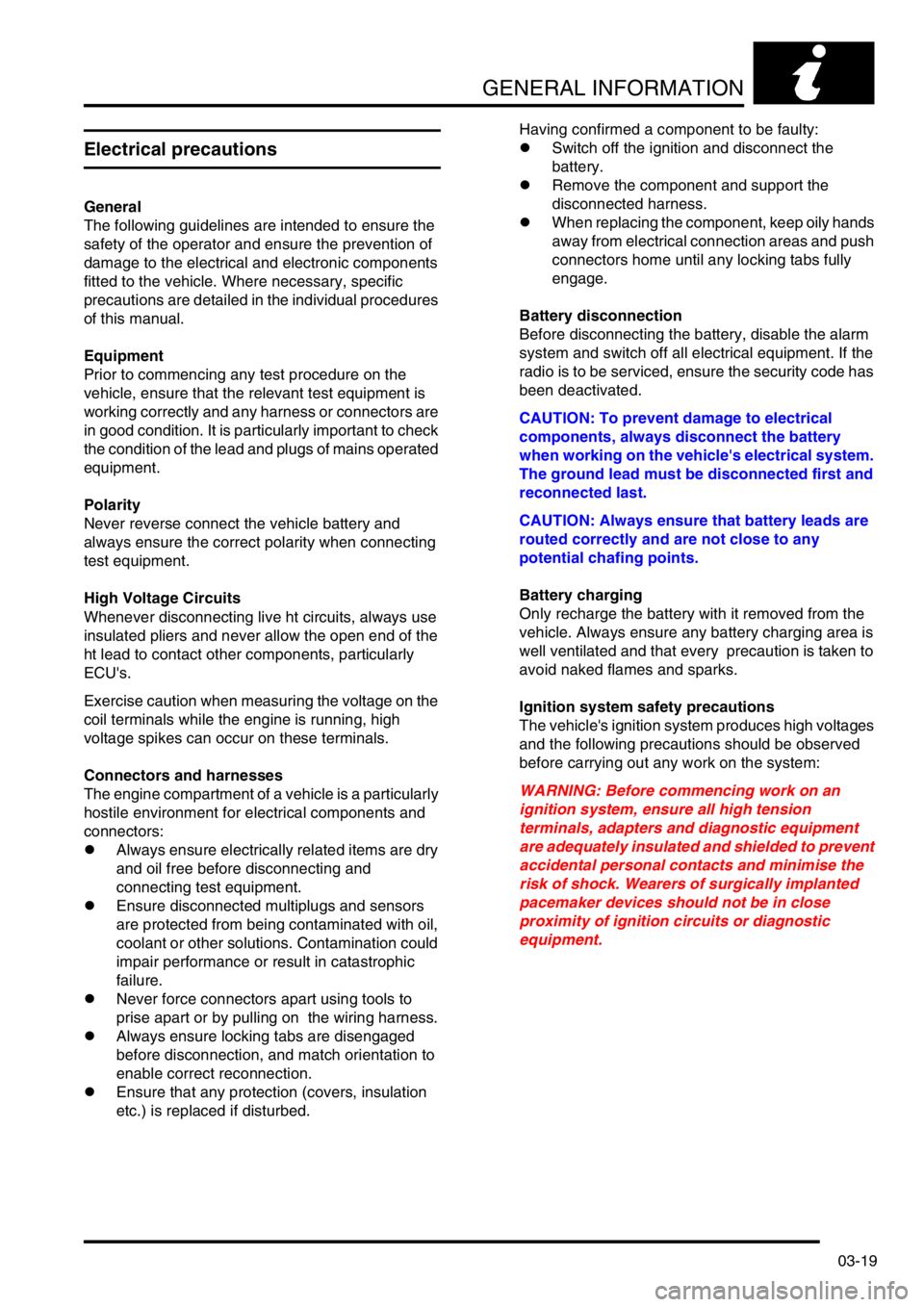
GENERAL INFORMATION
03-19
Electrical precautions
General
The following guidelines are intended to ensure the
safety of the operator and ensure the prevention of
damage to the electrical and electronic components
fitted to the vehicle. Where necessary, specific
precautions are detailed in the individual procedures
of this manual.
Equipment
Prior to commencing any test procedure on the
vehicle, ensure that the relevant test equipment is
working correctly and any harness or connectors are
in good condition. It is particularly important to check
the condition of the lead and plugs of mains operated
equipment.
Polarity
Never reverse connect the vehicle battery and
always ensure the correct polarity when connecting
test equipment.
High Voltage Circuits
Whenever disconnecting live ht circuits, always use
insulated pliers and never allow the open end of the
ht lead to contact other components, particularly
ECU's.
Exercise caution when measuring the voltage on the
coil terminals while the engine is running, high
voltage spikes can occur on these terminals.
Connectors and harnesses
The engine compartment of a vehicle is a particularly
hostile environment for electrical components and
connectors:
lAlways ensure electrically related items are dry
and oil free before disconnecting and
connecting test equipment.
lEnsure disconnected multiplugs and sensors
are protected from being contaminated with oil,
coolant or other solutions. Contamination could
impair performance or result in catastrophic
failure.
lNever force connectors apart using tools to
prise apart or by pulling on the wiring harness.
lAlways ensure locking tabs are disengaged
before disconnection, and match orientation to
enable correct reconnection.
lEnsure that any protection (covers, insulation
etc.) is replaced if disturbed.Having confirmed a component to be faulty:
lSwitch off the ignition and disconnect the
battery.
lRemove the component and support the
disconnected harness.
lWhen replacing the component, keep oily hands
away from electrical connection areas and push
connectors home until any locking tabs fully
engage.
Battery disconnection
Before disconnecting the battery, disable the alarm
system and switch off all electrical equipment. If the
radio is to be serviced, ensure the security code has
been deactivated.
CAUTION: To prevent damage to electrical
components, always disconnect the battery
when working on the vehicle's electrical system.
The ground lead must be disconnected first and
reconnected last.
CAUTION: Always ensure that battery leads are
routed correctly and are not close to any
potential chafing points.
Battery charging
Only recharge the battery with it removed from the
vehicle. Always ensure any battery charging area is
well ventilated and that every precaution is taken to
avoid naked flames and sparks.
Ignition system safety precautions
The vehicle's ignition system produces high voltages
and the following precautions should be observed
before carrying out any work on the system:
WARNING: Before commencing work on an
ignition system, ensure all high tension
terminals, adapters and diagnostic equipment
are adequately insulated and shielded to prevent
accidental personal contacts and minimise the
risk of shock. Wearers of surgically implanted
pacemaker devices should not be in close
proximity of ignition circuits or diagnostic
equipment.
Page 51 of 1007
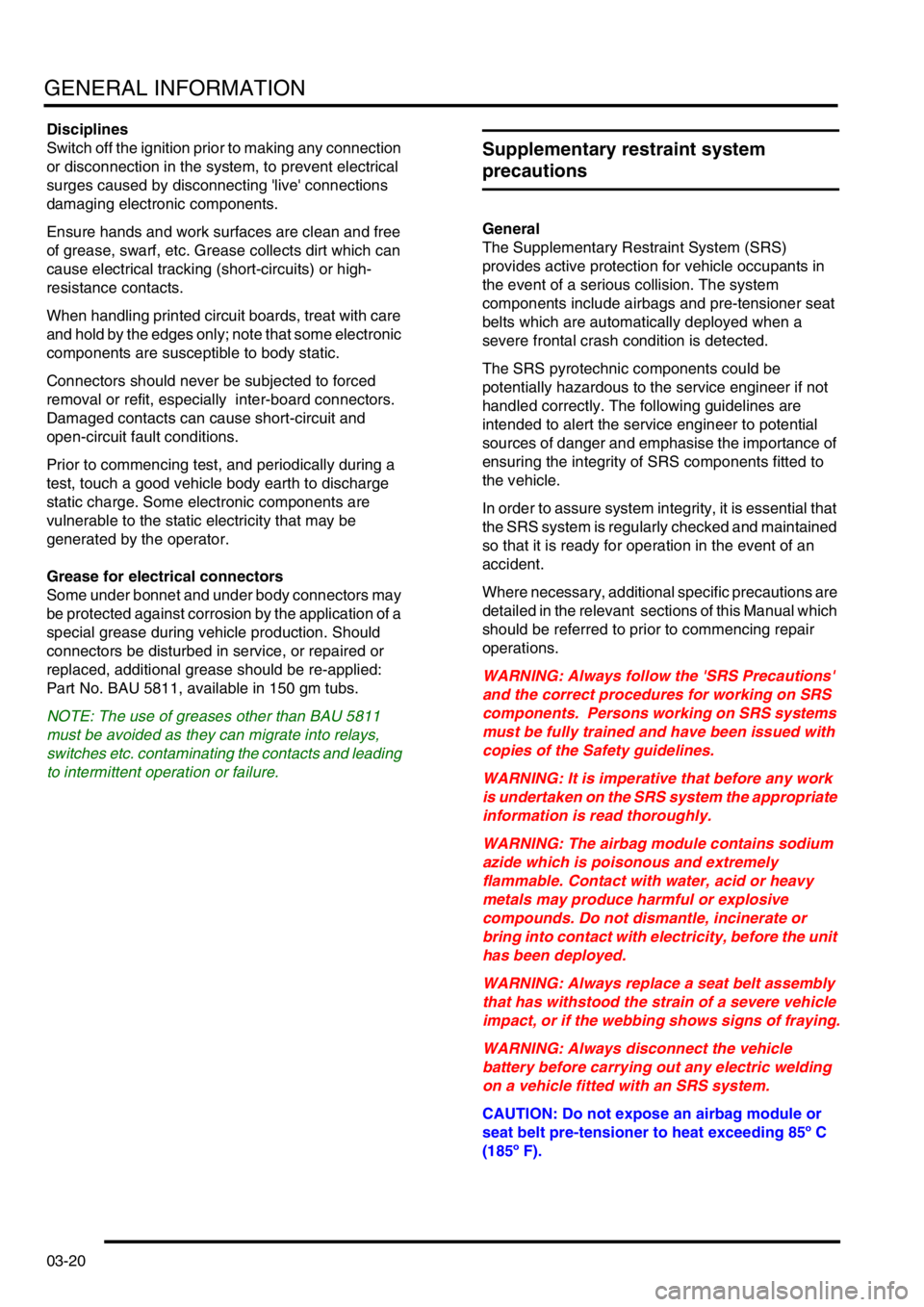
GENERAL INFORMATION
03-20
Disciplines
Switch off the ignition prior to making any connection
or disconnection in the system, to prevent electrical
surges caused by disconnecting 'live' connections
damaging electronic components.
Ensure hands and work surfaces are clean and free
of grease, swarf, etc. Grease collects dirt which can
cause electrical tracking (short-circuits) or high-
resistance contacts.
When handling printed circuit boards, treat with care
and hold by the edges only; note that some electronic
components are susceptible to body static.
Connectors should never be subjected to forced
removal or refit, especially inter-board connectors.
Damaged contacts can cause short-circuit and
open-circuit fault conditions.
Prior to commencing test, and periodically during a
test, touch a good vehicle body earth to discharge
static charge. Some electronic components are
vulnerable to the static electricity that may be
generated by the operator.
Grease for electrical connectors
Some under bonnet and under body connectors may
be protected against corrosion by the application of a
special grease during vehicle production. Should
connectors be disturbed in service, or repaired or
replaced, additional grease should be re-applied:
Part No. BAU 5811, available in 150 gm tubs.
NOTE: The use of greases other than BAU 5811
must be avoided as they can migrate into relays,
switches etc. contaminating the contacts and leading
to intermittent operation or failure.
Supplementary restraint system
precautions
General
The Supplementary Restraint System (SRS)
provides active protection for vehicle occupants in
the event of a serious collision. The system
components include airbags and pre-tensioner seat
belts which are automatically deployed when a
severe frontal crash condition is detected.
The SRS pyrotechnic components could be
potentially hazardous to the service engineer if not
handled correctly. The following guidelines are
intended to alert the service engineer to potential
sources of danger and emphasise the importance of
ensuring the integrity of SRS components fitted to
the vehicle.
In order to assure system integrity, it is essential that
the SRS system is regularly checked and maintained
so that it is ready for operation in the event of an
accident.
Where necessary, additional specific precautions are
detailed in the relevant sections of this Manual which
should be referred to prior to commencing repair
operations.
WARNING: Always follow the 'SRS Precautions'
and the correct procedures for working on SRS
components. Persons working on SRS systems
must be fully trained and have been issued with
copies of the Safety guidelines.
WARNING: It is imperative that before any work
is undertaken on the SRS system the appropriate
information is read thoroughly.
WARNING: The airbag module contains sodium
azide which is poisonous and extremely
flammable. Contact with water, acid or heavy
metals may produce harmful or explosive
compounds. Do not dismantle, incinerate or
bring into contact with electricity, before the unit
has been deployed.
WARNING: Always replace a seat belt assembly
that has withstood the strain of a severe vehicle
impact, or if the webbing shows signs of fraying.
WARNING: Always disconnect the vehicle
battery before carrying out any electric welding
on a vehicle fitted with an SRS system.
CAUTION: Do not expose an airbag module or
seat belt pre-tensioner to heat exceeding 85º C
(185º F).
Page 141 of 1007
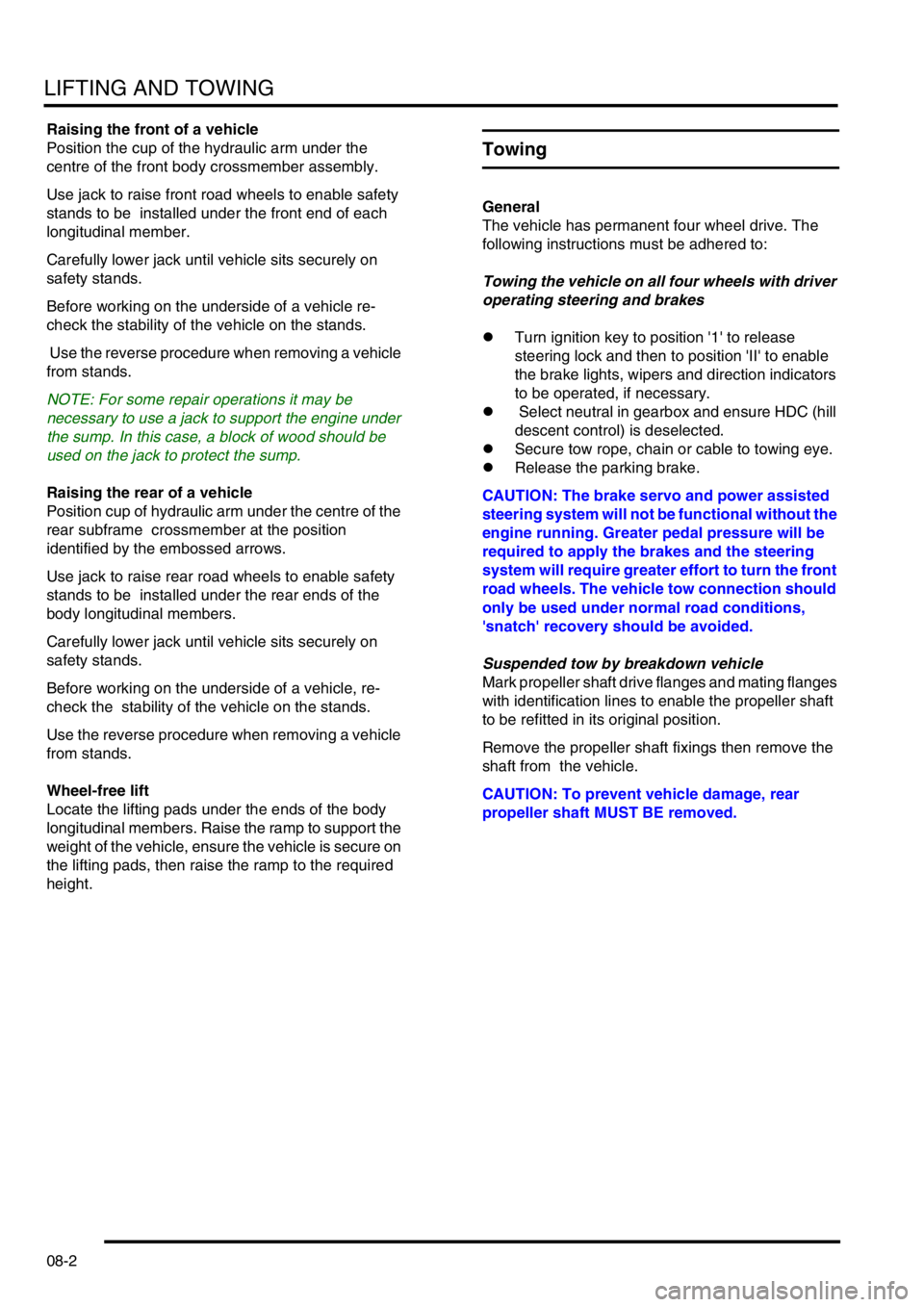
LIFTING AND TOWING
08-2
Raising the front of a vehicle
Position the cup of the hydraulic arm under the
centre of the front body crossmember assembly.
Use jack to raise front road wheels to enable safety
stands to be installed under the front end of each
longitudinal member.
Carefully lower jack until vehicle sits securely on
safety stands.
Before working on the underside of a vehicle re-
check the stability of the vehicle on the stands.
Use the reverse procedure when removing a vehicle
from stands.
NOTE: For some repair operations it may be
necessary to use a jack to support the engine under
the sump. In this case, a block of wood should be
used on the jack to protect the sump.
Raising the rear of a vehicle
Position cup of hydraulic arm under the centre of the
rear subframe crossmember at the position
identified by the embossed arrows.
Use jack to raise rear road wheels to enable safety
stands to be installed under the rear ends of the
body longitudinal members.
Carefully lower jack until vehicle sits securely on
safety stands.
Before working on the underside of a vehicle, re-
check the stability of the vehicle on the stands.
Use the reverse procedure when removing a vehicle
from stands.
Wheel-free lift
Locate the lifting pads under the ends of the body
longitudinal members. Raise the ramp to support the
weight of the vehicle, ensure the vehicle is secure on
the lifting pads, then raise the ramp to the required
height.
Towing
General
The vehicle has permanent four wheel drive. The
following instructions must be adhered to:
Towing the vehicle on all four wheels with driver
operating steering and brakes
lTurn ignition key to position '1' to release
steering lock and then to position 'II' to enable
the brake lights, wipers and direction indicators
to be operated, if necessary.
l Select neutral in gearbox and ensure HDC (hill
descent control) is deselected.
lSecure tow rope, chain or cable to towing eye.
lRelease the parking brake.
CAUTION: The brake servo and power assisted
steering system will not be functional without the
engine running. Greater pedal pressure will be
required to apply the brakes and the steering
system will require greater effort to turn the front
road wheels. The vehicle tow connection should
only be used under normal road conditions,
'snatch' recovery should be avoided.
Suspended tow by breakdown vehicle
Mark propeller shaft drive flanges and mating flanges
with identification lines to enable the propeller shaft
to be refitted in its original position.
Remove the propeller shaft fixings then remove the
shaft from the vehicle.
CAUTION: To prevent vehicle damage, rear
propeller shaft MUST BE removed.
Page 145 of 1007
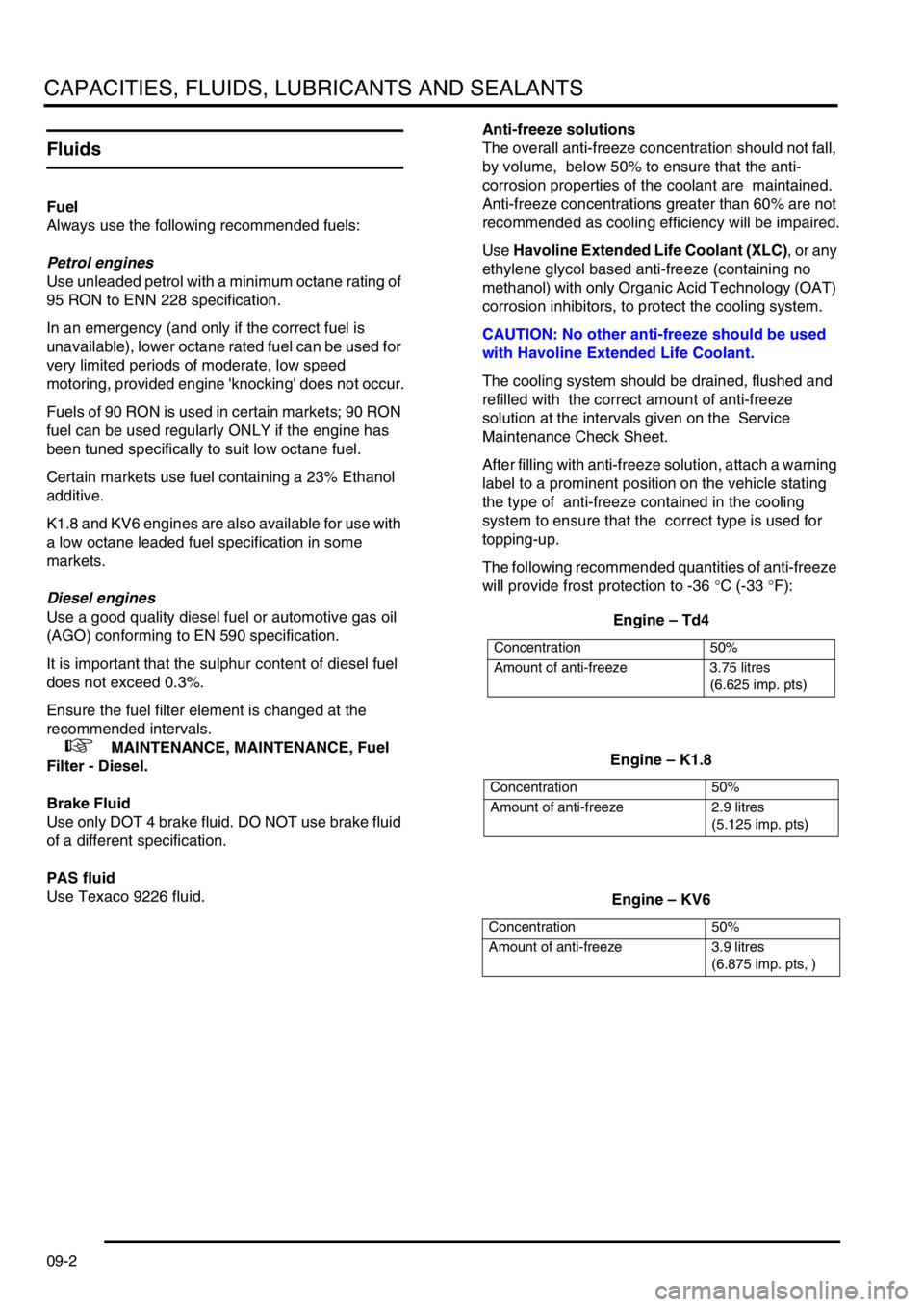
CAPACITIES, FLUIDS, LUBRICANTS AND SEALANTS
09-2
Fluids
Fuel
Always use the following recommended fuels:
Petrol engines
Use unleaded petrol with a minimum octane rating of
95 RON to ENN 228 specification.
In an emergency (and only if the correct fuel is
unavailable), lower octane rated fuel can be used for
very limited periods of moderate, low speed
motoring, provided engine 'knocking' does not occur.
Fuels of 90 RON is used in certain markets; 90 RON
fuel can be used regularly ONLY if the engine has
been tuned specifically to suit low octane fuel.
Certain markets use fuel containing a 23% Ethanol
additive.
K1.8 and KV6 engines are also available for use with
a low octane leaded fuel specification in some
markets.
Diesel engines
Use a good quality diesel fuel or automotive gas oil
(AGO) conforming to EN 590 specification.
It is important that the sulphur content of diesel fuel
does not exceed 0.3%.
Ensure the fuel filter element is changed at the
recommended intervals.
+ MAINTENANCE, MAINTENANCE, Fuel
Filter - Diesel.
Brake Fluid
Use only DOT 4 brake fluid. DO NOT use brake fluid
of a different specification.
PAS fluid
Use Texaco 9226 fluid.Anti-freeze solutions
The overall anti-freeze concentration should not fall,
by volume, below 50% to ensure that the anti-
corrosion properties of the coolant are maintained.
Anti-freeze concentrations greater than 60% are not
recommended as cooling efficiency will be impaired.
Use Havoline Extended Life Coolant (XLC), or any
ethylene glycol based anti-freeze (containing no
methanol) with only Organic Acid Technology (OAT)
corrosion inhibitors, to protect the cooling system.
CAUTION: No other anti-freeze should be used
with Havoline Extended Life Coolant.
The cooling system should be drained, flushed and
refilled with the correct amount of anti-freeze
solution at the intervals given on the Service
Maintenance Check Sheet.
After filling with anti-freeze solution, attach a warning
label to a prominent position on the vehicle stating
the type of anti-freeze contained in the cooling
system to ensure that the correct type is used for
topping-up.
The following recommended quantities of anti-freeze
will provide frost protection to -36 °C (-33 °F):
Engine – Td4
Engine – K1.8
Engine – KV6
Concentration 50%
Amount of anti-freeze 3.75 litres
(6.625 imp. pts)
Concentration 50%
Amount of anti-freeze 2.9 litres
(5.125 imp. pts)
Concentration 50%
Amount of anti-freeze 3.9 litres
(6.875 imp. pts, )